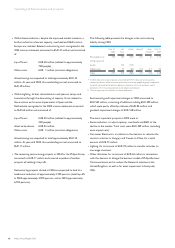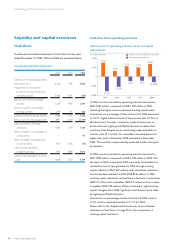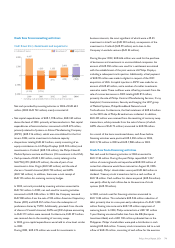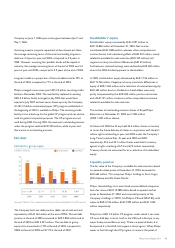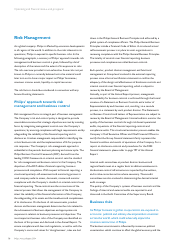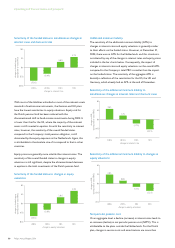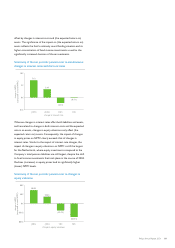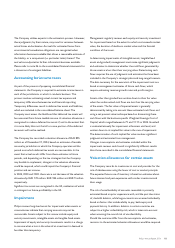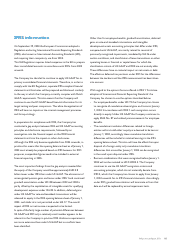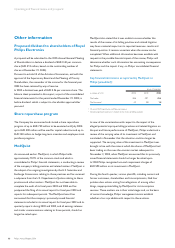Philips 2004 Annual Report Download - page 79
Download and view the complete annual report
Please find page 79 of the 2004 Philips annual report below. You can navigate through the pages in the report by either clicking on the pages listed below, or by using the keyword search tool below to find specific information within the annual report.Such acquisitions could expose Philips to integration risks, in
particular in the areas of logistics, information technology,
accounting and human resources.
Philips’ extensive use of strategic alliances may result in
conflicts of interest, loss of control over investments and
loss of control over proprietary technologies.
Philips operates in high-tech markets with rapid technological
development, which requires the Company to make large financial
investments. Philips continues to utilize partnerships in order to
share the risks associated with large investments. These
partnerships take place through minority shareholdings, joint
ventures and majority shareholdings. Managing this growing
number of strategic alliances, and in particular bridging the
international, legal and cultural differences, is a growing risk in
itself. In addition, Philips may face conflicts of interest, loss of
control over cash flows and loss of proprietary technologies by
participating in joint ventures.
Philips’ success is dependent on technological innovation
and its ability to secure and retain intellectual property
rights for its products.
Philips’ longer-term success depends on technological innovation,
global standards and its ability to obtain and retain licenses and
other intellectual property (IP) rights covering its products and its
design and manufacturing processes. The IP portfolio results from
an extensive patenting process that might be challenged by open
innovation, strategic alliances, outsourced development and
changes in regulations. The value of the IP portfolio is dependent
on the successful promotion and market acceptance of standards
developed or co-developed by Philips. Philips might lose a
substantial part of its license revenue if it is not able to generate
new licenses or to enforce its IP entitlements.
Philips is dependent on a decreasing number of business
partners.
Further globalization and concentration of its customer and supply
base makes Philips increasingly dependent on a limited number of
business partners, posing challenges to existing management and
control structures in many of its businesses.
Because Philips is dependent on its personnel for highly
specialized technical and other skills, the loss of its ability to
attract and retain such personnel would have an adverse
affect on its business.
The retention of highly specialized technical personnel, as well as
talented employees in sales and marketing, research and
development, finance and general management, is critical to the
success of the Company.
Philips’ global presence exposes the Company to regional
and local regulatory rules, which may interfere with the
realization of business opportunities and investments in the
countries in which the Company operates.
Being a global company, Philips has established subsidiaries in over
60 countries. The subsidiaries are exposed to changes in
governmental regulations and unfavorable political developments,
which may limit the realization of business opportunities or impair
local Philips investment.
Philips is exposed to a variety of financial risks, including
currency fluctuations, interest rate fluctuations, equity price
risk and credit risk, which may impact Philips’ results.
Currency fluctuations may impact Philips’ financial results in a
number of ways. Furthermore, Philips is exposed to interest rate
risk, commodity price risk, equity price risk and credit risk. Philips
owns available-for-sale securities and is a minority shareholder in a
number of participations, of which the market value currently
exceeds the equity investment reported in the financial
statements. Sale of some or all of these assets would positively
influence Philips’ net income. Decline of the market value of these
investments could result in future impairments. For qualitative and
quantitative disclosure about financial risks, please refer to note 34
of the consolidated financial statements.
Warranty and product liability claims against Philips could
cause Philips to incur significant costs and affect Philips’
results as well as its reputation and relationships with key
customers, which could affect Philips’ results.
Philips is from time to time subject to warranty and product
liability claims with regard to product performance. Philips could
incur product liability losses as a result of repair and replacement
costs in response to customer complaints or in connection with
resolution of contemplated or actual legal proceedings relating to
such claims. In addition to potential losses from claims and related
legal proceedings, product liability claims could affect Philips’
reputation and its relationships with key customers. As a result,
product liability claims could impact Philips’ financial results.
Legal proceedings covering a range of matters are pending
in various jurisdictions against the Company and its
subsidiaries. Due to the uncertainty inherent in litigation, it
is difficult to predict the final outcome. An adverse outcome
may impact Philips’ results.
The Company, including certain of its subsidiaries, is involved in
litigation relating to such matters as competition issues,
commercial transactions, product liability (involving allegations of
personal injury from alleged asbestos exposure), participations and
environmental pollution. Although the final outcome of matters in
78 Philips Annual Report 2004
Operating and financial review and prospects


